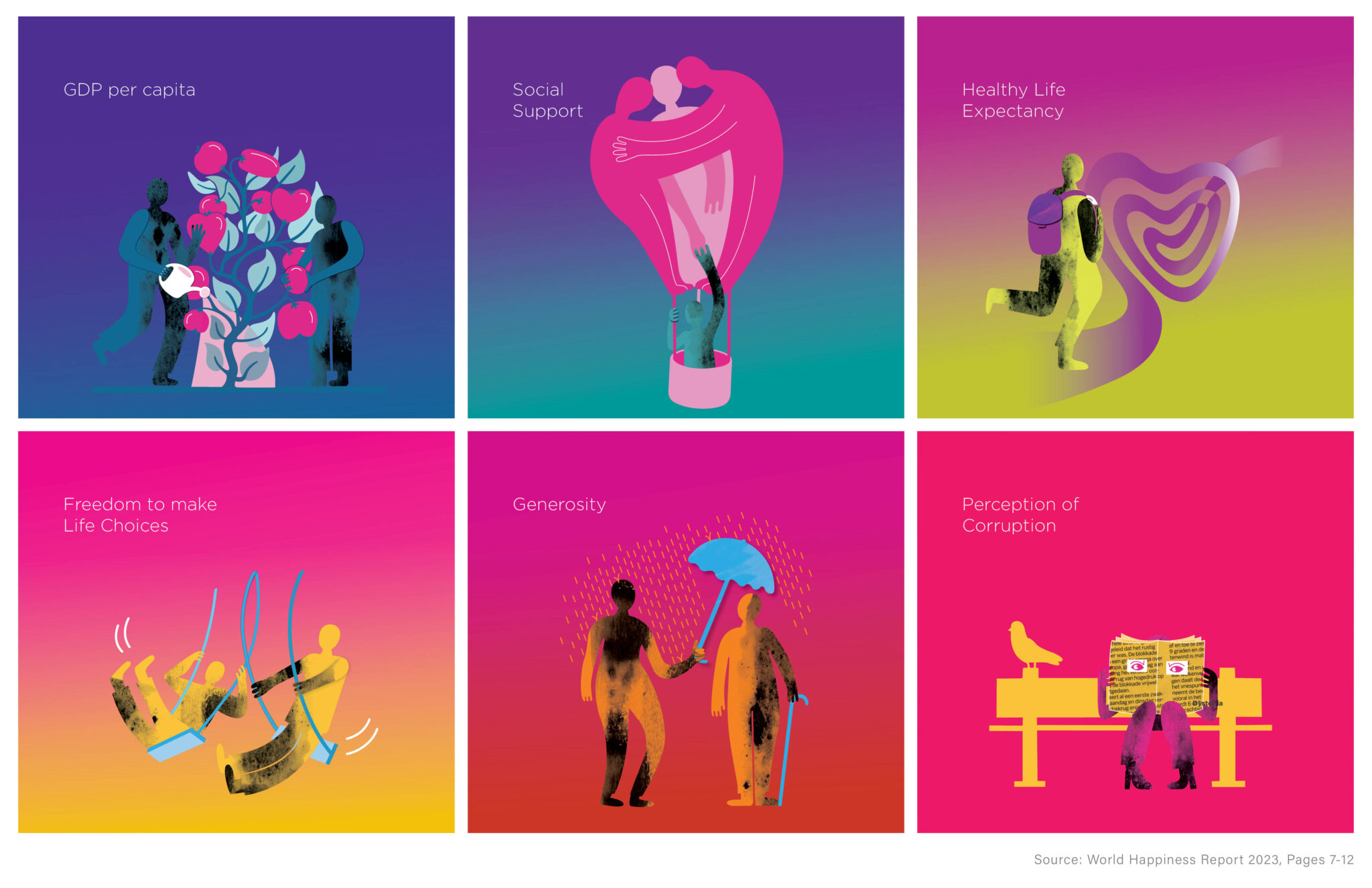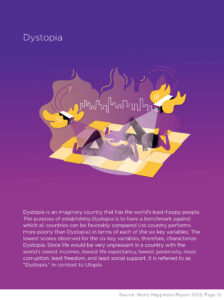Imagine you are standing before a ladder with ten rungs, each step representing a degree of satisfaction with life. At the ground, you’re at the lowest point; but the higher you climb on this ladder, the closer you are to your best possible life. Where on this ladder do you see yourself standing? All things considered, how satisfied are you with your life? If you extend this thought exercise to your broader community, how well do you think you and your neighbors would fare, collectively, when compared to communities elsewhere in the world?
This simple yet powerful image represents a measure of life satisfaction that is often used in social science research. The Cantril Ladder, as it is called, has proven to be an effective tool for measuring life satisfaction at the individual, community, and even national levels, making it useful for comparing satisfaction across time and place; and this is precisely how scientists can produce annual global rankings of the happiest places around the world.
Published by the UN Sustainable Development Solutions Network (SDSN), the World Happiness Report (WHR) aggregates survey data from the 160 countries surveyed in the Gallup World Poll, in which respondents are asked to self-report their own life satisfaction. It is released annually on the International Day of Happiness—which happens to be today, meaning the much-anticipated WHR23 was just published this morning. All across the globe, policymakers, social scientists, mental health professionals, design professionals, and folks from all backgrounds and interests are now tuning in to see what the WHR authors have to say about the state of happiness on Earth in 2023.
As the basis for the WHR national rankings, the Gallup life satisfaction scores are further examined against six quality of life factors believed to attribute to individual life evaluation scores and thus thought to shine additional light on the differences in overall scores at the national-level. Each of these six variables—levels of Gross Domestic Product (GDP), life expectancy, generosity, social support, freedom, and corruption—are calculated so that all countries perform favorably when compared to a dystopian baseline. In contrast to the idea of Utopia (an imagined society where life is perfect), WHR’s Dystopia is a hypothetical country where each of the six factors score at the bottom, making Dystopia home to the world’s least-happy people.

 The fictitious Dystopia may be useful as a benchmark, but researchers are interested in understanding is how well our world’s very real nations are doing, and why some countries tend to consistently appear at the top of the WHR’s rankings, whereas others seem stuck toward the bottom. Although the six quality of life factors explored in the WHR do not impact a country’s overall score, researchers use these variables in an attempt to explain the rankings and things like why Finland, for instance, has now held their position at the top for six years in a row.
The fictitious Dystopia may be useful as a benchmark, but researchers are interested in understanding is how well our world’s very real nations are doing, and why some countries tend to consistently appear at the top of the WHR’s rankings, whereas others seem stuck toward the bottom. Although the six quality of life factors explored in the WHR do not impact a country’s overall score, researchers use these variables in an attempt to explain the rankings and things like why Finland, for instance, has now held their position at the top for six years in a row.
The national ranking is a sensational part of the WHR, and no doubt becomes fodder for national marketing materials and political propaganda. But perhaps the true value of each WHR is the wealth of additional research published within. Findings from scientific studies and scholarly interpretations of the latest social science data present a rich inventory of knowledge and topics to further investigate as we seek to understand what contributes to the differences in happiness levels across countries.
Over ten years after the first World Happiness Report, this year’s report seized the milestone opportunity to look back at the trends observed in national happiness and to look forward to happiness in the next ten years.
Notably, the report highlights that “more and more people have come to believe that our success as countries should be judged by the happiness of our people” (page 2). At the same time, research in the science of happiness has proven the reliability and efficacy of methods for measuring well-being, making it possible for governments to set national happiness as an operational objective. As nations put happiness on the agenda for the next ten years, the 2023 World Happiness Report advises nations to put happiness at the center…in policy, in education, in the workplace, etc.
“We need this more than ever.” Said co-author Jeffrey Sachs in a day-of virtual launch of the 2023 World Happiness Report. “Our world is not in a happy state; in fact, it’s in a very perilous state.” To visualize exactly what Sachs means by this, we can now explore the full data in a brand new interactive World Happiness Report data dashboard that allows us to view data from all past reports.

As Sachs and the 2023 World Happiness Report note, people don’t achieve happiness on their own; rather, happiness is achieved in societies. Humans are social animals. The role of society, thus, is to nurture good people, which can be achieved by fostering strong virtues and high eudaimonia, or life satisfaction.
The World Happiness Report’s research is an incredible resource for design professionals. Beyond the six factors specifically tracked in the WHR, additional variables are thought to influence levels of happiness, and many are tied to our social, urban, and natural environments. For instance, research in past reports have highlighted that environmental elements like nearby natural spaces and parks are understood to boost positive moods. Additionally, the annual reports continue to explain how an individual’s social surroundings play a significant part in shaping their well-being since a strong social environment can provide things like a confidant to count upon and increased feelings of trust, freedom, and generosity.
The challenge for designers, then, is to more fully understand the implications of happiness research to form a better approach to shaping environments that cater to the happiness needs of occupants and users. Recognizing the critical role of social networks in supporting an individual’s happiness, can we shape spaces that cultivate connection, foster trust, and nurture pro-social behaviors? When we’re developing policies, what would it mean to put happiness at the center? In the decisions we’re making today, how can we more accurately and equitably consider the needs of and impacts on the larger population? As designers seek answers to these questions, it is critical to act swiftly to stay aligned with evolving national priorities.
In 2011, recognizing that the pursuit of happiness is a fundamental human motivation (and certainly a more meaningful goal to individuals than seeking to boost the GDP), the UN adopted resolution 665/309, “Happiness: Towards a Holistic Definition of Development.” In doing so, the UN invited Member States to pursue the advancement of happiness and well-being in development by exploring solutions outside the narrow focus on economic indicators. The first World Happiness Report was published a year later in April 2012.
As nations have become increasingly interested in cultivating places that promote a greater quality of life across many facets, project scopes have similarly begun to prioritize well-being in design. Recognizing that the built environment can either contribute to or detract from the qualities of place, design professionals are positioned to step into roles as happiness harbingers and well-being cultivators. And every project presents an opportunity.
When the WHR and existing science of well-being research indicate the existence of strong correlations between qualities of a place and society and the happiness of inhabitants, there is no project too small—no decision too trivial—for designers to lift the spirits of a space’s occupants and help nudge the life satisfaction bar a little bit further.
—
Megan Oliver, AICP, WELL AP, is an Associate Planner at Mahan Rykiel Associates. Believing in the power of place to profoundly influence our mood and behavior, Megan is driven to design and shape spaces that foster healing and joy. Through her research-based design approach, Megan applies the science of human experience and perception to urban design and planning strategies. She employs storytelling, public art, placemaking, livability planning, and responsive spatial design interventions to foster strong communities and cultivate happier, more inclusive spaces and places. Over the past decade+ of her planning career, Megan has utilized a holistic and person-centric approach to help over one hundred communities craft visions for the future.
To learn more about how Megan and the designers at Mahan Rykiel Associates can help prioritize happiness in your community, please reach out to mra@mahanrykiel.com.
[…] This piece was originally posted on the website of landscape architecture firm, Mahan Rykiel Associates. […]